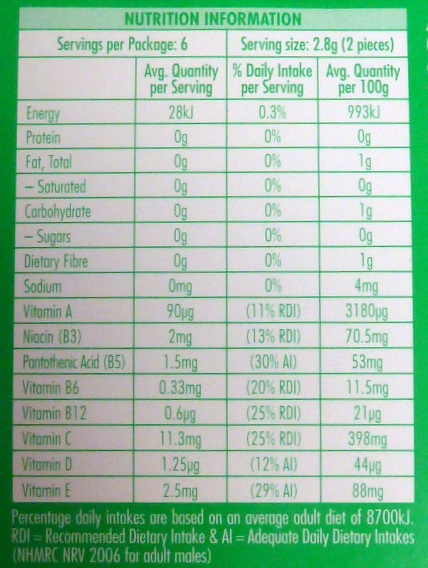Product Snapshot: Cenovis Vitamin Gum

Vitamin chewing gum is the latest kid on the, if-we-add-a-few-vitamins-people-will-think-it's-healthy, block! Well, on the plus side it is sugar-free so at least your teeth are safe. But seriously, are there any benefits to vitamin enriched chewing gum? Let's take a look...
The product and its pitch
Cenovis Vitamin Gum comes in three flavours – grape, spearmint and peppermint. The first two are labelled “Multivitamin”and spruiked as contributing to “normal energy production and normal immune system function”. The peppermint gum however is labelled “stress and energy” and flagged as contributing to “the reduction of tiredness and fatigue, normal energy production and normal nervous system function”.
So what’s the difference between the vitamins in the grape and spearmint and those in the peppermint gum? The ONLY difference we can see between them is that the latter has an extra 2mg of Niacin (Vitamin B3). Really?! 2 mg of B3 turns a product from multivitamin to easing stress and fatigue?
The Recommended Daily Intake for B3 is 14 to 16 mg for adults. Does anyone really believe an extra 2 mg will de-stress you and reduce your fatigue? Especially if you’re not actually going to get much anyway – see below.
My concerns
The serving size for these gums is 2 pieces and the recommended daily dose is 6 – 8 pieces which would take you close to, or over, the RDI for some the vitamins. However, no one seems to know how much is actually absorbed by your body. My colleague rang the info line and asked because it says suitable for 4 years and up, yet shows average ADULT recommended intakes.
The recommended dietary intake (RDI) for 4 to 8 year olds is 8 mg per day so 8 pieces of grape or spearmint gum would give them their full dose - yet they’d also be getting it from other sources as B3 is used to fortify many foods including cereals and some breads. 8 pieces of the peppermint would give them 16 mg - twice the RDI, yet the safe upper limit for intake from ALL fortified foods or supplements per day is only 15 mg for this age group.
When the issue of the safety of this gum for young children was raised with the woman on the information line, her first response was to say that she wouldn’t let a child that young use chewing gum. Then why does the pack say "4 years and up" then?
Her second response was that most vitamins are absorbed in the small intestine so you won’t actually get much of a vitamin hit from the gum. When asked if this was just window dressing then, a way of making people feel they were making a healthy choice even though they wouldn’t absorb much? Her response was that it was good for a “top-up”. In my opinion, that sounds like trying to have your cake and eat it. It’s either effective – in which case four year olds could easily get too much or it isn’t effective and it’s just an attempt to give chewing gum a health halo.
List of ingredients
Sorbitol, maltitol, gum base, maltitol syrup (maltitol, sorbitol), flavour, vitamins, vegetable gum 414, colours 171, 102, 133, glazing agent 903, 904, sweetener 955, 961, emulsifier, 322 - soy lecithin.
This list shows that this gum – like any other sugarfree gum – is a highly processed food, requiring lots of additives to bind together and give a pleasant chewing experience. Here’s what these do in the gum:
| Additive number |
Compound |
| 414 | gum Arabic or acacia gum |
| 171 | titanium dioxide, white colour |
| 102 | tartrazine, yellow colour |
| 133 | FCF, brilliant blue colour |
| 903 | carnuba wax |
| 904 | shellac |
| 955 | sucralose (trade name Splenda) |
| 961 | neotame, a no-kilojoule sweetener that has a greater stability than the commonly used aspartame |
| 322 | lecithin derived from soy |
Note: Tartrazine (colour 102) has a couple of black spots against it and has been removed from many coloured lollies and snacks so it’s surprising to see it here. However, you’d only ingest tiny quantities of it.
Apart from the added vitamins, there are two sugar alcohols (sorbitol and maltitol as well as the syrup) which provide the base and some sweetness. But it still needs two intense sweeteners (sucralose - 955 and neotame - 961) to give the full hit of sweetness without kilojoules. Plus there’s a stabilizing gum to keep the pellets moist and prevent drying out, three colours which are a white, yellow and blue, plus two waxes which are classified as glazing agents. Not forgetting a little lecithin to keep things nicely stable when mixed.
The taste
We bought the spearmint gum to try and the flavour was pleasant. You are supposed to chew two pieces for 10 minutes to get the best effect. The gum claims to have long lasting flavour and the flavour did last 10 minutes – just.
The verdict
If you are going to chew gum anyway then why not this? It is sugar free, has a pleasant flavour that lasts and you MAY get a small dose of vitamins. If you’re looking for an easier way to get a vitamin top up than swallowing large vitamin pills then this just won’t cut it I’m afraid. You’ll find it in the lolly aisle (that should tell you something) in the supermarket.




